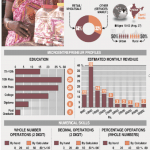How Microfinance Can Impact Employment: Going Beyond Microloans to Microentrepreneurs
Microfinance and employment have always gone hand-in-hand. Though its focus has shifted in recent years, the theory of change that launched the microfinance movement posited that microloans would empower low-income borrowers to create self-employment opportunities through entrepreneurship. The sector has since moved on to emphasize the much broader benefits of financial inclusion, but employment remains among its core impact goals.
Craig Churchill is head of the Social Finance Programme at the International Labour Organization (ILO), where he leads the program’s efforts to explore how banks, microfinance institutions (MFIs), insurers and investors can contribute to the ILO’s agenda of promoting decent work. He moderated a plenary on “Protecting the Working Poor in the 21st Century Through Responsible Finance” at last year’s European Microfinance Week, and we caught up with him to discuss the ways modern microfinance can positively impact employment.
As Churchill described it, plenty of options exist. Since offering small loans to microenterprises doesn’t make a reliable impact on employment, MFIs should expand their support to startups, he said. Though these are businesses MFIs have typically avoided, they can be a big piece of the job creation conversation.
“Another agenda for MFIs is to not only consider the quantity of jobs they’re creating, but also the quality of work,” he added. “Typically, if you’re a loan officer and you’re going out to visit MFI clients, you’ll observe a lot of deplorable working conditions in those business. But what do the loan officers do about it? What do they do if they see occupational safety and health risks, or when they see chemicals being stored in ways that are quite dangerous, or people working exorbitant hours?
“This is one of the things that we’re trying to get banks and MFIs to embrace more actively – not necessarily out of a CSR or social responsibility agenda, but because it makes sense for them as well,” he explained. “They want to find ways of reducing their clients’ exposure to risks, as a way of reducing the bank’s exposure to risks as well.”
As Churchill described it, MFIs react to this new priority in different ways. “For financial institutions that have a double bottom line, this really resonates with them, because they are trying to achieve impact, and they recognize that they’re not having sufficient impact. So they’re looking for tools and resources and processes that enable them to have greater results with their customers.”
However, financial institutions that are more commercially oriented are less receptive to this type of engagement with clients – something he views as short-sighted. “I think it’s taking the short-term view. With the commercial MFIs or banks, we’re trying to get them to see that this makes sense for them. It doesn’t have to be a significant extra cost for them to have a greater impact.”
In the interview below, Churchill discusses how MFIs should respond when they see poor labor practices among their clients – including the thorny issue of child labor, explores the pros and cons of gig economy work (and how it overlaps with financial inclusion), and discusses other ways the financial industry can better serve the low-income labor force.
James Militzer is an editor at NextBillion.
- Categories
- Finance



